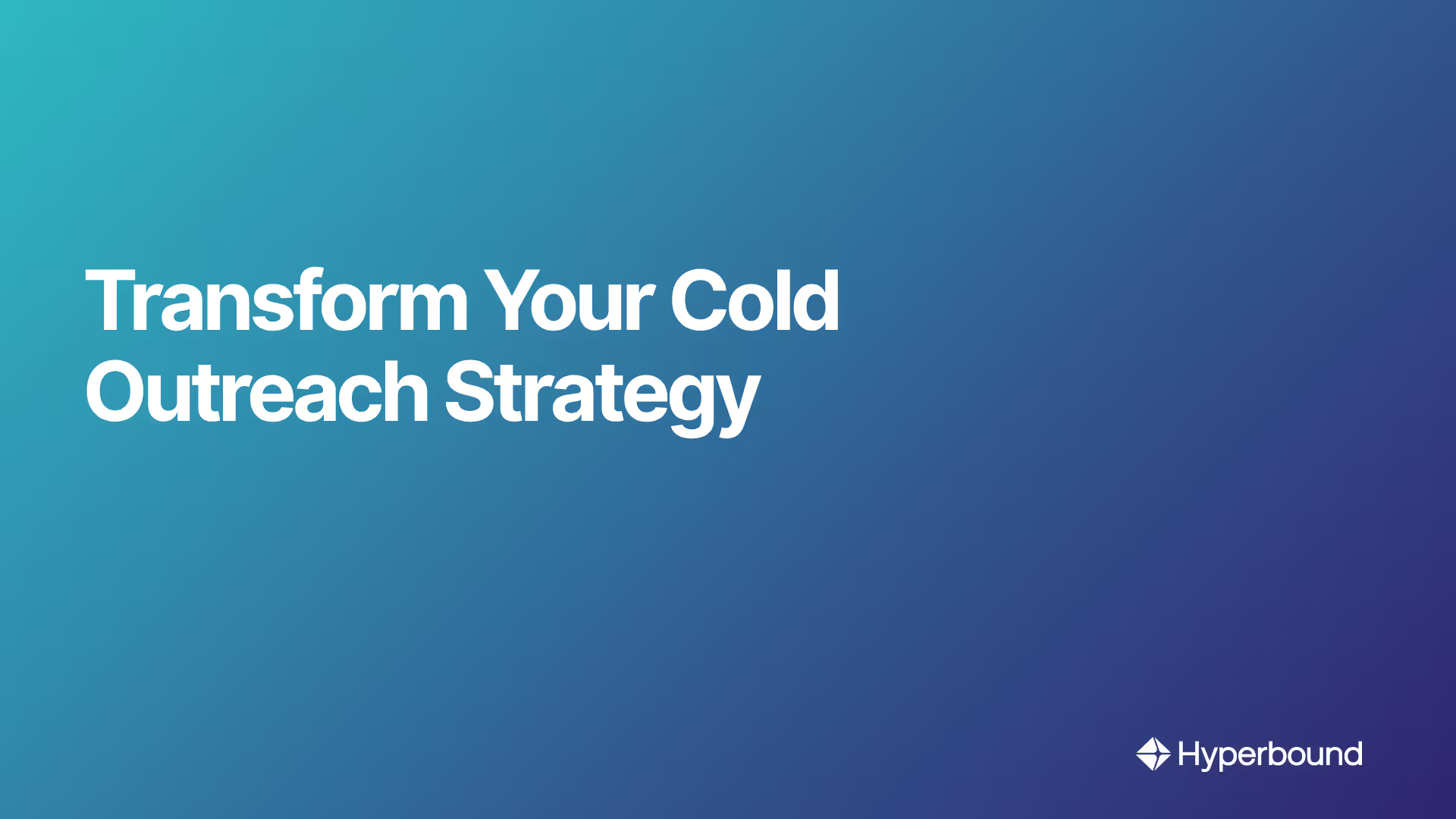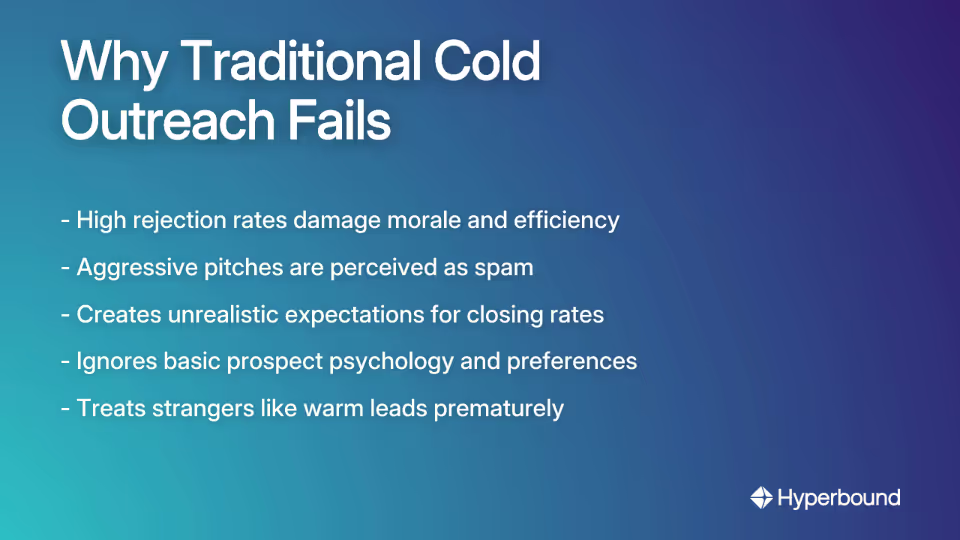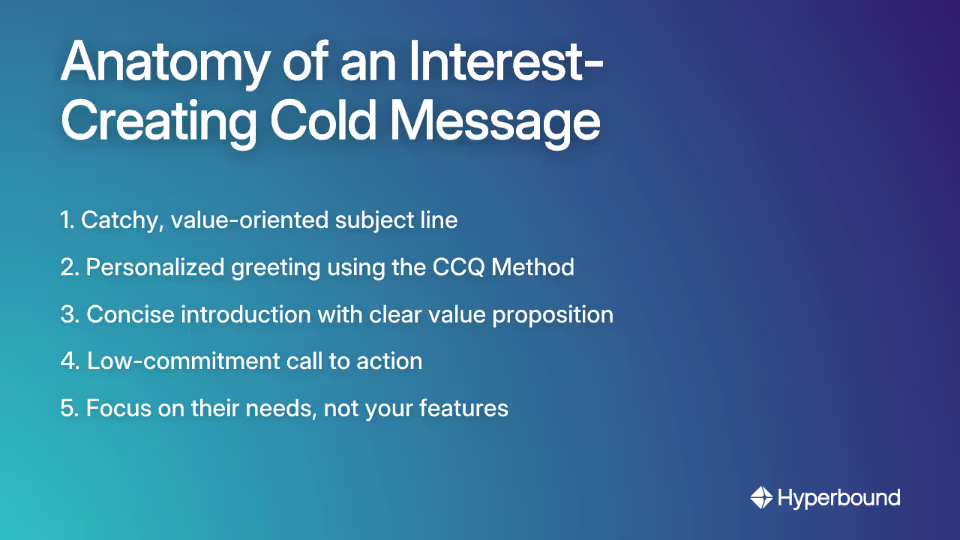
You've spent hours perfecting that cold email template. You've A/B tested subject lines, tweaked individual words in your talk track, and rehearsed your pitch until you could recite it in your sleep. Yet the results remain frustratingly consistent: silence, rejection, or polite brush-offs.
Sound familiar?
The problem isn't your effort or even your execution. It's your goal.
As one seasoned sales professional put it: "Cold outreach is marketing, not sales. Do not reach out Cold to close. Reach out Cold to inform and create interest."
This fundamental misunderstanding of cold outreach's purpose has led countless sales professionals down a path of frustration, with many accepting that facing objections "99% of the time" is simply "part of the game." But it doesn't have to be this way.
In this guide, we'll explore why shifting from a closing mindset to an interest-creation approach transforms cold outreach from a dreaded necessity into a powerful tool for building a healthy pipeline of warm leads. We'll examine the psychology behind this shift, provide actionable strategies for creating genuine interest, and redefine how success should be measured in your outreach efforts.
The Misconception: Why Pitching to Close Fails
Cold outreach, at its core, is the process of initiating contact with potential customers who have shown no prior interest in your products or services. This typically happens through emails, phone calls, or social media DMs.
The traditional approach positions cold outreach as a numbers game: contact enough people, and eventually someone will buy. This closing-focused mindset brings with it several inherent problems:
High Rejection & Negative Perception
When you reach out cold with the intention to close, you're essentially asking a stranger to make a commitment before they know, like, or trust you. This creates immediate resistance and dramatically increases the likelihood of rejection.
As one sales professional candidly shared: "I do cold calling. From the part of getting rejected, hung up and facing objections like 99% of the time. I've accepted it's part of the game and most of the time prospects just lie to your face."
This high rejection rate isn't just disheartening—it's inefficient.
Damages Trust & Brand Credibility
In today's world, where inboxes are "more crowded than ever," many AI-driven outreach tools focus on sheer volume, making personalization seem impossible and aggressive sales pitches feel like spam. This perception damages your personal brand and your company's reputation. The key is using technology not just to send more, but to prepare your team to connect better.
Creates Unrealistic Expectations
Even with "insanely warm inbound leads," closing in a single conversation is rare—"1 in 1000" according to one sales leader. Applying this expectation to cold outreach is setting yourself up for failure and frustration.
Ignores Prospect Psychology
Research consistently shows that "most people hate receiving marketing emails but are happy to be reached out to for advice, information, or a no-pressure video call." A pitch-first approach ignores this reality, prioritizing your agenda over the prospect's preferences.
The fundamental issue is that traditional cold outreach treats strangers like warm leads, asking for commitment before providing value. This approach contradicts basic human psychology and the natural progression of business relationships.

The Mindset Shift: From High-Pressure Sales to High-Value Education
The solution isn't to abandon cold outreach—it's to transform your approach from high-pressure selling to high-value educating. This shift repositions cold outreach as a marketing function rather than a sales tactic.
The Core Shift: From "What Can I Sell?" to "What Value Can I Provide?"
The fundamental mindset shift is changing your primary objective from "closing a deal" to "creating interest and educating." This transforms your approach from "what can I sell them?" to "what value can I provide them?" This is the essence of modern lead generation versus old-school selling.
When your goal becomes providing value and creating interest, several powerful benefits emerge:
Reduced Pressure on Both Sides
When you remove the immediate expectation of a sale, you take enormous pressure off both yourself and your prospect. This creates space for more natural, meaningful conversations where genuine connections can form.
No longer are you desperately trying to overcome objections or push for commitment. Instead, you're sharing valuable insights, asking thoughtful questions, and genuinely exploring whether there's a fit. This approach feels better for everyone involved.
A Healthier Pipeline with Warmer Leads
By focusing on creating interest rather than closing deals, you nurture a pipeline of educated, engaged prospects who understand your value proposition and have shown genuine interest in learning more. These warm leads convert at significantly higher rates than those pushed prematurely toward a decision.
This directly counters what one marketer identified as a common mistake: "Most people try to maximize 'leads' instead of using them for their real purpose which is to identify a qualified audience worth targeting further."
Higher Quality Conversations
A value-first approach fundamentally changes the nature of your interactions. When you're not pushing for a sale, you can ask better questions, listen more attentively, and tailor your follow-up based on genuine needs rather than script adherence.
This improvement in conversation quality leads to better buyer persona development, deeper understanding of pain points, and ultimately more effective objection handling when you do reach the sales stage.
Long-Term Trust and Authority Building
By sharing valuable content, offering insights, or providing free consultations, you position yourself as a trusted advisor rather than just another salesperson. This builds the foundation of trust necessary for any significant business relationship.
As your reputation for providing value grows, so does your authority in your space—making future outreach efforts even more effective and reducing resistance to your messages.

The Playbook: Actionable Strategies for Creating Genuine Interest
Now that we understand the why, let's explore the how of interest-focused cold outreach. The following strategies will help you transform your approach from spray-and-pray sales pitches to targeted, value-driven engagement.
Foundation First: Hyper-Personalization and Quality Lists
The foundation of effective interest-creation is working with the right prospects and approaching them in genuinely personalized ways. Here's how:
Stop the Spray and Pray Approach
One of the most common mistakes in cold outreach is casting too wide a net. As one sales veteran put it: "Too many people make a huge list of low quality prospects and waste time and energy."
Instead, focus on building a smaller, highly targeted list of prospects who are most likely to benefit from what you offer. Quality trumps quantity every time in modern outreach.
Build In-Depth Prospect Lists
Don't just buy a generic list based on broad criteria. Analyze your best current customers to identify patterns in industry, company size, job titles, and challenges. Use these insights to build a targeted prospect list that mirrors your ideal customer profile.
This approach aligns with the worldview that "The purpose of lead generation is actually to narrow down who to focus on and not to maximize!"
Do Your Research Homework
Before any outreach, thoroughly research each prospect. Use LinkedIn, their company website, recent news, and social media to understand their role, recent achievements, and potential challenges. This information is gold for personalization.
Look for trigger events—recent funding, leadership changes, expansions, or new initiatives—that make your outreach timely and relevant.
Embrace "Ultra-Personalization"
Your goal should be to craft a message that could only be for this specific person. This is the antidote to generic, AI-driven outreach that floods inboxes today. Reference specific details from your research that demonstrate you've done your homework and care about their unique situation.
Crafting the Irresistible Message
With your foundation in place, it's time to craft messages that create genuine interest. Here's the anatomy of a value-first outreach:
Catchy, Value-Oriented Subject Line
Your subject line should promise value, not push for a sale. Compare:
❌ "Quick call about our software solution?"
✅ "3 insights from your competitor's recent strategy shift"
The second option offers immediate value and piques curiosity without asking for anything in return.
Personalized Greeting & Opener
Use the prospect's name and reference something specific you learned in your research. The CCQ Method provides an excellent framework for your opening line:
- Compliment: Genuinely compliment them on a recent achievement ("Congrats on the recent funding round")
- Commonality: Mention a shared connection or interest ("I saw we both attended the same conference")
- Question: Ask a relevant, insightful question about their work
This approach immediately differentiates your message from generic templates.
Concise Introduction & Clear Value Proposition
Briefly introduce yourself and your company, then quickly pivot to how you can help them solve a problem or achieve a goal. Focus on their needs, not your features.
Use analogies if needed to clarify your unique value proposition. For example, comparing a business without your solution to a car without wheels can vividly illustrate a critical gap you fill.
Low-Commitment Call to Action (CTA)
Instead of pushing for a demo or sales call, propose a much easier next step. As one recipient of cold emails noted, they respond to messages that are "short, straight to the point, and have something to offer."
Consider CTAs like:
- "Would a brief guide on [relevant topic] be helpful?"
- "I have a 2-minute video explaining how [company similar to theirs] solved this issue—would that be worth watching?"
- "Can I send you our latest research on [industry trend]?"
These low-pressure CTAs make it easy to say yes and begin the relationship.

Beyond the Inbox: Innovative Channels for Modern Outreach
While email remains a staple, diversifying your outreach channels can dramatically improve results:
Direct Mail / "Lumpy Mail"
In a digital world, physical mail stands out. As one outreach specialist discovered: "Personalized letters. Old school, but I've gotten higher response rates than emails. I sent clean, nice looking envelopes and I truly believe that makes a difference."
Consider sending thoughtful, relevant direct mail pieces to key prospects. Items that relate to your value proposition or a recent conversation can be particularly effective.
Personalized Video Messages
Video messaging tools allow you to send short, personal video messages that put a face to your name. These are far more engaging than plain text and help build connection quickly.
A simple 30-60 second video that references the prospect's specific situation can cut through the noise of crowded inboxes.
Educational Webinars and Content
Invite prospects to educational webinars or workshops where you provide value before asking for anything in return. This positions you as an expert and gives prospects a low-risk way to experience your thinking.
Feature Prospects on Your Podcast or Blog
One of the most powerful ways to build relationships is to showcase your prospects' expertise. Inviting them to share their insights on your platform gives them exposure while creating a natural reason for continued conversation.
Multi-Channel Approach
Combine LinkedIn messaging with cold emails and other touch points. If one channel doesn't generate a response, a different approach on another platform might. Use a CRM to track these touches and ensure a coordinated approach.
The Art of the Follow-Up
Persistence is key in outreach, but how you persist makes all the difference:
The Rule of Persistence
Avoid giving up too soon. Research shows that most engagement happens after the initial touch. Allocate fixed time for outreach and commit to a consistent follow-up schedule.
Use a Structured Sales Cadence
Implement a structured approach like the Fibonacci sequence: reach out at increasing intervals (Day 1, Day 2, Day 3, Day 5, Day 8, Day 13, etc.). This maintains contact without overwhelming the prospect.
Vary Your Message and Offer New Value
Each follow-up should offer fresh value or a different perspective. Avoid generic "just checking in" messages that add no value. Instead, share a new insight, resource, or question with each touch.
Measuring What Matters: Redefining Success in Cold Outreach
If your goal isn't to close deals through cold outreach, how do you measure success? It's time to shift your key performance indicators (KPIs) to align with an interest-creation approach:
Key Metrics for Interest-Focused Outreach
Open Rates & Response Rates
These basic metrics tell you whether your message is getting through and generating engagement. Low open rates suggest your subject lines need work, while low response rates might indicate your message isn't resonating or your call to action isn't compelling enough.
Lead Conversion Rate to Next Stage
Rather than measuring closed deals from cold outreach, track how many prospects take the small next step you've offered. This might be downloading a resource, watching a video, or agreeing to a brief exploratory call.
This conversion rate becomes your primary success indicator, as it shows you're successfully creating interest and moving prospects into your nurturing process.
Quality of Conversations
While harder to quantify, the quality of your interactions is a crucial metric. Are prospects asking thoughtful questions? Are they openly sharing their challenges? Are they engaging beyond the minimum required response?
Lead Qualification Rate
How many of the prospects you engage with meet your qualification criteria and enter your sales funnel as warm leads? This metric helps you refine your targeting and approach over time.
A/B Testing with Purpose
Testing is valuable, but don't fall into the trap of "perfection paralysis." As one sales professional confessed: "I wasted a lot of time tweaking one word in my talk track or A/B testing emails... I spent more time worried about small fixes than I did just hitting the phones."
Use A/B testing to evaluate significant changes in your approach—such as entirely different value propositions or calls to action—rather than agonizing over minor word choices. Remember, action beats perfection every time.
The recommendation from experienced professionals is simple: "Just do it. Be human." Focus on being genuine and relatable rather than achieving perfection in your messaging.
Building Your Pipeline by Building Interest
The shift from closing-focused to interest-focused cold outreach isn't just a tactical adjustment—it's a fundamental reimagining of how business relationships begin and develop.
By embracing cold outreach as a marketing function rather than a sales tactic, you align your approach with basic human psychology and the natural progression of business relationships. You stop trying to sell to strangers and start creating opportunities for meaningful connections based on value and mutual interest.
This approach addresses the core challenges faced by outreach professionals today:
- It cuts through the noise of overcrowded inboxes by offering genuine value rather than generic pitches
- It reduces rejection by removing premature pressure to commit
- It improves the quality of every conversation by focusing on education and exploration rather than objection handling
- It builds a healthier pipeline of warm leads who understand your value and have expressed genuine interest
As we navigate increasingly crowded digital spaces and evolving buyer expectations, this mindset shift becomes not just beneficial but essential for sustainable success.
Remember the powerful worldview that should guide your outreach efforts: "The purpose of lead generation is actually to narrow down who to focus on and not to maximize!" Shift your focus from quantity of leads to quality of interest, and watch your pipeline transform.
Cold outreach isn't for closing—it's for creating interest, building relationships, and starting meaningful conversations that eventually lead to mutually beneficial business relationships. Master this approach, and you'll stand out in a sea of pitches as someone who truly understands how modern business relationships form and develop.
Ultimately, by letting go of the pressure to close and embracing the opportunity to educate and create interest, you'll not only generate better results but also enjoy the process of outreach far more. And in a profession where persistence is essential, that enjoyment might be the most valuable outcome of all.
Frequently Asked Questions
Why is my cold outreach not working?
Your cold outreach is likely not working because its primary goal is to close a sale rather than create interest. This approach asks a stranger for a commitment before any trust or relationship has been built, leading to immediate resistance and high rejection rates. By shifting your goal to educating and providing value, you align with the prospect's preference for information over a high-pressure sales pitch.
What should be the primary goal of cold outreach?
The primary goal of cold outreach should be to create interest and educate your prospect. Treat it as a marketing function designed to identify qualified prospects and guide them into your sales funnel as warm leads. By focusing on providing value—such as sharing insights or helpful content—you build trust and position yourself as an advisor, nurturing a pipeline of engaged prospects who are more likely to convert later.
How can I make my cold emails more effective?
To make your cold emails more effective, focus on hyper-personalization, a value-oriented subject line, and a low-commitment call to action (CTA). Your message should be tailored to the prospect's specific situation and needs, not your product's features. Research each prospect to find a genuine reason to connect, and instead of asking for a demo, offer a valuable resource like a guide, short video, or relevant research to make it easy for them to say "yes."
What are good examples of a low-commitment Call to Action (CTA)?
Good examples of low-commitment CTAs offer value without asking for a meeting. Effective options include: "Would a brief guide on [relevant topic] be helpful?", "I have a 2-minute video explaining how [similar company] solved this—would that be worth watching?", or "Can I send you our latest research on [industry trend]?" These CTAs work because they propose an easy, valuable next step that starts a conversation without pressure.
How do I measure the success of cold outreach if not by sales?
Measure the success of interest-focused cold outreach by tracking engagement metrics like response rates, the conversion rate to the next stage, and the overall quality of conversations. The key is to monitor how many prospects take the small, low-commitment step you've offered (e.g., downloading a resource or watching a video). This shows you're successfully creating interest and moving prospects into your nurturing process.
How can I personalize outreach at scale without it taking all day?
You can personalize outreach at scale by focusing on a smaller, higher-quality list of prospects and looking for specific "trigger events" (like a promotion or company news) for each one. The goal is genuine, timely connection, not perfection. This approach of "ultra-personalization" on a targeted list is far more effective than generic, high-volume outreach and helps you avoid spending too much time tweaking minor details in your messages.

Book a demo with Hyperbound
.png)













